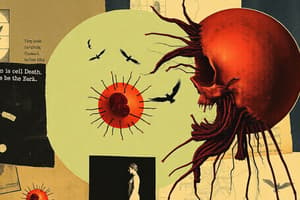Podcast
Questions and Answers
What is the most damaging reactive oxygen species (ROS) responsible for damaging lipids, proteins, and DNA?
What is the most damaging reactive oxygen species (ROS) responsible for damaging lipids, proteins, and DNA?
- Superoxide
- Hydroxyl (correct)
- Hydrogen peroxide
- Peroxynitrite
- Oxygen-derived free radical
Which process is characterized by the tightly regulated intracellular program that requires synthesis and activation of signaling and effector proteins?
Which process is characterized by the tightly regulated intracellular program that requires synthesis and activation of signaling and effector proteins?
- Lysosomal degradation
- Necrosis
- Inflammation
- Oxidative phosphorylation
- Apoptosis (correct)
What is one of the causes of apoptosis as an adaptive response to pathology?
What is one of the causes of apoptosis as an adaptive response to pathology?
- Lysosomal degradation
- Necrosis
- Death of host cells that served their purpose (correct)
- Oxidative phosphorylation
- Inflammation
Which cellular process is implicated in both cancer cell death and survival?
Which cellular process is implicated in both cancer cell death and survival?
What is the final common pathway in dystrophic calcification?
What is the final common pathway in dystrophic calcification?
Where does metastatic calcification primarily occur?
Where does metastatic calcification primarily occur?
Which type of necrosis is characterized by the architecture of dead cells being preserved?
Which type of necrosis is characterized by the architecture of dead cells being preserved?
What are examples of cellular adaptations to stress?
What are examples of cellular adaptations to stress?
What are the definitions of reversible and irreversible cell injury?
What are the definitions of reversible and irreversible cell injury?
What are the types of insults to tissues or cells mentioned in the text?
What are the types of insults to tissues or cells mentioned in the text?
What does the cellular response to injury depend on?
What does the cellular response to injury depend on?
What are examples of long-term extracellular damage patterns mentioned in the text?
What are examples of long-term extracellular damage patterns mentioned in the text?
Which factor significantly influences cellular injury?
Which factor significantly influences cellular injury?
What are the pathophysiologic consequences of reversible cell injury?
What are the pathophysiologic consequences of reversible cell injury?
What are the mechanisms of necrosis?
What are the mechanisms of necrosis?
What can calcium accumulation in the cytosol lead to?
What can calcium accumulation in the cytosol lead to?
What are the effects of membrane damage during ischemic injury?
What are the effects of membrane damage during ischemic injury?
Which family of proteins includes both anti-apoptotic and pro-apoptotic members?
Which family of proteins includes both anti-apoptotic and pro-apoptotic members?
What is the major role of caspases 3 and 6 in the intrinsic pathway of apoptosis?
What is the major role of caspases 3 and 6 in the intrinsic pathway of apoptosis?
What is the adaptive response to injurious stimuli such as radiation and cytotoxic anticancer drugs?
What is the adaptive response to injurious stimuli such as radiation and cytotoxic anticancer drugs?
What is the microscopic pathology of apoptosis characterized by?
What is the microscopic pathology of apoptosis characterized by?
What leads to the release of pro-apoptotic molecules into the cytoplasm in the intrinsic pathway of apoptosis?
What leads to the release of pro-apoptotic molecules into the cytoplasm in the intrinsic pathway of apoptosis?
What is the mechanism of activation for necroptosis?
What is the mechanism of activation for necroptosis?
Which process leads to the synthesis of p53 and subsequent apoptosis?
Which process leads to the synthesis of p53 and subsequent apoptosis?
What is the primary function of caspases 8, 9, and 10 in apoptosis?
What is the primary function of caspases 8, 9, and 10 in apoptosis?
What triggers the initiation of the extrinsic pathway of apoptosis?
What triggers the initiation of the extrinsic pathway of apoptosis?
What is the morphological resemblance of necroptosis to necrosis?
What is the morphological resemblance of necroptosis to necrosis?
Which of the following is true about Fas receptor and Fas ligand interaction?
Which of the following is true about Fas receptor and Fas ligand interaction?
What is the mechanism of activation for necroptosis?
What is the mechanism of activation for necroptosis?
Which factor triggers apoptosis via the intrinsic (mitochondrial) pathway?
Which factor triggers apoptosis via the intrinsic (mitochondrial) pathway?
What is the role of Bcl-2 and Bcl-x in apoptotic pathways?
What is the role of Bcl-2 and Bcl-x in apoptotic pathways?
What is the main difference between necroptosis and necrosis?
What is the main difference between necroptosis and necrosis?
Flashcards
Apoptosis
Apoptosis
Programmed cell death, removing harmful self-reactive lymphocytes.
Cytotoxic T cells
Cytotoxic T cells
Cells that induce apoptosis to fight viruses and tumors.
Transplant rejection
Transplant rejection
Apoptosis eliminates transplanted cells.
Injurious stimuli
Injurious stimuli
Signup and view all the flashcards
Pathological apoptosis
Pathological apoptosis
Signup and view all the flashcards
Misfolded proteins
Misfolded proteins
Signup and view all the flashcards
ER stress
ER stress
Signup and view all the flashcards
Atrophy/involution
Atrophy/involution
Signup and view all the flashcards
Apoptotic bodies
Apoptotic bodies
Signup and view all the flashcards
Phagocytosis
Phagocytosis
Signup and view all the flashcards
Intrinsic pathway
Intrinsic pathway
Signup and view all the flashcards
Extrinsic pathway
Extrinsic pathway
Signup and view all the flashcards
Mitochondrial outer membrane
Mitochondrial outer membrane
Signup and view all the flashcards
Pro-apoptotic molecules
Pro-apoptotic molecules
Signup and view all the flashcards
BCL2 family
BCL2 family
Signup and view all the flashcards
Anti-apoptotic proteins
Anti-apoptotic proteins
Signup and view all the flashcards
Pro-apoptotic proteins
Pro-apoptotic proteins
Signup and view all the flashcards
Caspases
Caspases
Signup and view all the flashcards
Cytochrome C
Cytochrome C
Signup and view all the flashcards
BH3-only proteins
BH3-only proteins
Signup and view all the flashcards
DNA damage
DNA damage
Signup and view all the flashcards
Growth factors
Growth factors
Signup and view all the flashcards
BH4 molecules
BH4 molecules
Signup and view all the flashcards
Execution stage
Execution stage
Signup and view all the flashcards
Initiation stage
Initiation stage
Signup and view all the flashcards
Cellular repair mechanisms
Cellular repair mechanisms
Signup and view all the flashcards
Study Notes
Apoptosis: Key Concepts and Pathological Mechanisms
- Apoptosis is a programmed cell death mechanism that eliminates potentially harmful self-reactive lymphocytes before or after maturation.
- Cell death can be induced by cytotoxic T cells as a defense mechanism against viruses and tumors, and it is also responsible for the rejection of transplanted cells.
- Apoptosis is an adaptive response to various injurious stimuli such as radiation and cytotoxic anticancer drugs, which can lead to cell death if repair mechanisms fail to cope with the damage.
- Pathological apoptosis can occur during the accumulation of misfolded proteins, ER stress, and unfolded proteins, as well as in cases of atrophy/involution of secretory tissues in parenchymal organs after duct obstruction.
- The microscopic pathology of apoptosis involves cell shrinkage, chromatin condensation, the formation of cytoplasmic blebs and apoptotic bodies, and the subsequent phagocytosis of apoptotic cells by macrophages.
- Apoptosis involves two major stages – initiation and execution – and two major types – the intrinsic (mitochondrial) pathway and the extrinsic (death-receptor) pathway.
- The intrinsic pathway results from cellular damage or lack of growth factors, leading to increased permeability of the mitochondrial outer membrane and the release of pro-apoptotic molecules into the cytoplasm.
- The release of pro-apoptotic proteins is controlled by the BCL2 family of proteins, which includes anti-apoptotic (Bcl-2, Bcl-X, Mcl-1) and pro-apoptotic (Bax, Bak, Bim, Bad, Bid, Puma, Noxa) members.
- ER stress, lack of growth signals, and DNA damage can increase pro-apoptotic proteins, while the lack of BH4 molecules and BH3-only molecules can activate the mitochondrial leak channel, leading to cytochrome C leakage and activation of caspases.
- The balance between anti-apoptotic and pro-apoptotic members of the BCL2 family determines whether a cell will pursue apoptosis.
- Key executioner caspases in the intrinsic pathway include caspases 3 and 6, which are activated by cytochrome C and play a crucial role in the execution of apoptosis.
- Apoptosis is a highly regulated process involving complex molecular mechanisms and can occur in response to various physiological and pathological stimuli.
Studying That Suits You
Use AI to generate personalized quizzes and flashcards to suit your learning preferences.




